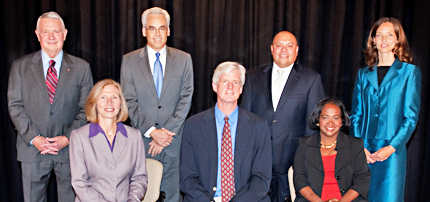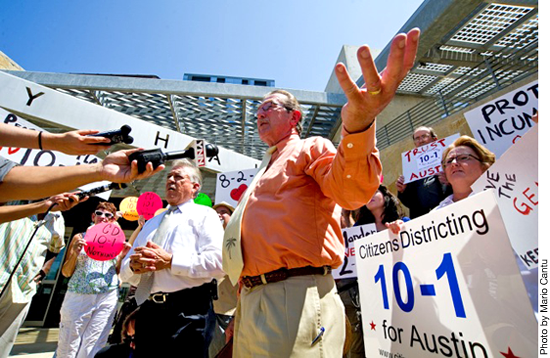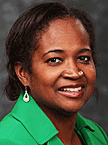City Charter
Ethics? Who gives a damn?
AG Sues to Remove Planning Commissioners
Attorneys Argue CodeNEXT Petition
No-Change Option Surfaces in Ballot Debate
Former Council Member Bob Binder opposes both
options on the ballot for geographic representation
by Ken Martin
© The Austin Bulldog 2012
Posted Tuesday, September 11, 2012 2:41pm
Monday's lunchtime debate drew about 40 people to hear arguments for not just Propositions 3 and 4 on the November 6 ballot, but reasons why voters should once again turn thumbs down to both plans for geographic representation in City Council elections.
 The program was hosted by the Central Texas Democratic Forum, emceed by attorney Chuck Herring of Herring & Irwin LLP.
The program was hosted by the Central Texas Democratic Forum, emceed by attorney Chuck Herring of Herring & Irwin LLP.
Until this debate, virtually all discussions about how council members should be elected have focused on the problems with the current all-at-large system and advocated for one of two proposed plans for change.
The Election Wars Have Begun
Interest in how council members elected
running high, as face-off debates abound
by Ken Martin
©The Austin Bulldog 2012
Posted Sunday, September 9, 2012 9:01pm
If you're concerned with how your local city government officials get elected—and how any change in the election system might affect your interests—you will have numerous opportunities to hear a thorough airing of the issues.
Two propositions on the city’s November 6 ballot offer choices for getting away from the all-at-large system we've had since 1953, when the council had five places and the elected council members chose the mayor from among their ranks. The council was expanded to seven places beginning with the 1969 election but it wasn’t until 1971 that citizens could directly elect their mayor.
Today, there are some who advocate keeping the election system we’ve got. However, the two major factions striving for change both advocate a new system of electing council members.
How to change is where they differ.
Your Guide to Proposed City Charter Amendments
What’s on the ballot, how much it will cost taxpayers, and
by Ken Martin
© The Austin Bulldog
Posted Thursday August 30, 2012 8:20pm
 When Austin voters go to the polls starting October 22 for the November 6 general election, they’ll be faced with a potentially bewildering 18 propositions on the City of Austin’s portion of the ballot.
When Austin voters go to the polls starting October 22 for the November 6 general election, they’ll be faced with a potentially bewildering 18 propositions on the City of Austin’s portion of the ballot.
And voters won’t see those propositions until they’ve finished wading through voting for federal, state and local candidates, and deciding whether to support Central Health’s proposed 5 cent tax hike to help fund a new medical school in Austin.
The Austin City Council and a number of citizens are really, really hoping voters don’t just vote a straight party ticket and go home. At stake are $385 million in seven bond propositions, 10 separate proposals to change the City Charter, and one proposition to allow emergency medical personnel to get the same civil service protections as police and firefighters.
Other down-ballot taxing jurisdictions on the ballot are also hoping to keep the voters attention long enough to mark the entire ballot, including Austin Independent School District, Austin Community College, and a bunch more.
In an effort to de-mystify the Austin portion of the ballot, The Austin Bulldog is providing the exact ballot language for each of the 10 propositions involving charter amendments and the emergency medical services proposition, and links to the ordinances that placed each of those on the ballot.
Loud Rally Follows Final Council Vote For 8-2-1
AGR Cries Foul Over Work Session Votes for Hybrid;
Mayor Leffingwell Said Votes Driven by Ballot Deadline
by Ken Martin
© The Austin Bulldog 2012
Posted Tuesday, August 7, 2012 9:07pm

A high-noon rally by a loud crowd of Austinites for Geographic Representation (AGR) pulled no punches in criticizing the Austin City Council for casting a final vote today to put the 8-2-1 plan for electing council members on the same ballot as the 10-1 plan the group got on the ballot through petition.
AGR’s main complaints are that there was no groundswell of support for the 8-2-1 plan; that it goes against the recommendations of the council-appointed 2012 Charter Revision Committee, which recommended the 10-1 plan; and that it adds confusion and competition for voter approval of any form of geographic representation. Previous opportunities to enact some form of geographic representation have been voted down six times between 1973 and 2002.
A secondary issue for AGR is that only the first reading of the ordinance to put the 8-2-1 plan on the ballot was voted on in a regular City Council meeting, while the last two readings were voted on in council work sessions.
Two hours before the press conference, during the morning portion of today’s council work session, Mayor Lee Leffingwell announced that the votes taken in work session were driven by the deadline to approve measures to go on the ballot.
8-2-1 Plan Certain to Go on Ballot
8-2-1 Plan Near-Certain to Go on Ballot
City Council Votes on Second Reading
to Put Competing Election Plan on Ballot
by Ken Martin
© The Austin Bulldog 2012
Posted July 31, 2012 2:35pm
The Austin City Council in today’s work session voted 5-2 (Council Members Mike Martinez and Bill Spelman opposed) to put the 8-2-1 plan for electing council members on the November ballot.  A five-vote majority is sufficient to pass any measure on the council’s agenda on all three readings for final approval, and dispense with further consideration. Today, at Mayor Pro Tem Sheryl Cole’s request, the vote was limited to second reading only.
A five-vote majority is sufficient to pass any measure on the council’s agenda on all three readings for final approval, and dispense with further consideration. Today, at Mayor Pro Tem Sheryl Cole’s request, the vote was limited to second reading only.
It now appears to be a foregone conclusion that at least four votes in favor of the 8-2-1 plan will be cast on third reading, which Mayor Lee Leffingwell said he anticipated would be scheduled for an August 7 work session.
That will set up head-to-head competition on the November ballot between the 8-2-1 plan and the 10-1 plan, which already garnered sufficient signatures to go on the ballot.







